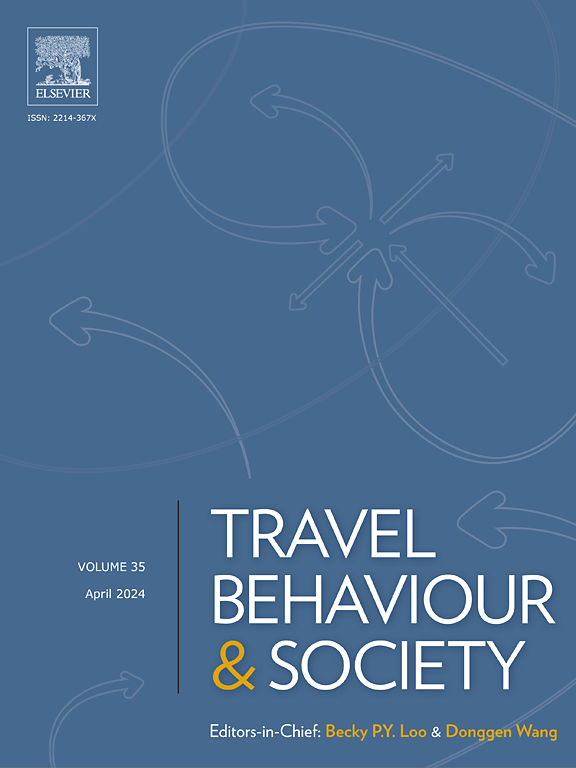在暂停和脉冲之间:旅行时间如何影响香港城市街道实验中的选择退出偏好
IF 5.7
2区 工程技术
Q1 TRANSPORTATION
引用次数: 0
摘要
街道实验干预越来越多地用于测试替代街道功能,但它们对旅行时间的影响及其与美学和社会效益的权衡仍然缺乏量化,特别是在密集的城市环境中。现有的方法严重依赖于定性的试错实验,为干预设计提供有限的经验指导。本研究引入了一个定量框架,结合生成人工智能(GenAI)和陈述偏好模型来评估香港公众对街头实验的接受程度。genai制作的逼真可视化用于150名参与者的调查(1200次观察)。估计了一个嵌套的logit模型,通过放宽从MNL继承的无关选择独立性(IIA)属性,扩展了多项logit (MNL)方法。这种结构捕捉了干预类型之间的相关偏好,同时将选择退出替代方案视为现状偏见的明显表现。研究人员考察了不同道路类型(小巷、人行道、次要道路、主要道路)、暂时性(临时与永久性、一天中的时间)、干预形式(自行车道、共享空间、口袋公园、户外餐厅)和旅行时间影响的偏好。结果表明,人们对旅行时间中断非常反感,即使是轻微的延误也会大大降低人们的接受度。视觉上吸引人,以座位和绿色植物为特色的社会活力干预是首选,而与自行车相关的基础设施则遇到文化和空间的阻力。选择退出的行为在老年人、人口密集地区的居民、受教育程度较低的个人和经常使用公共交通的人中尤为明显,这反映了时间敏感性、空间限制和对现有交通网络的依赖。研究结果强调了明确建模选择退出的重要性,并为设计适合高密度亚洲城市的渐进式和社会接受的街道实验提供了一个可转移的、数据驱动的框架,从而推进了战术城市主义的证据基础。本文章由计算机程序翻译,如有差异,请以英文原文为准。
Between pause and pulse: How travel time shapes opt-out preferences in Hong Kong’s urban street experiments
Street experimental interventions are increasingly used to test alternative street functions, yet their impacts on travel time and their trade-offs with aesthetic and social benefits remain poorly quantified, particularly in dense urban environments. Existing approaches rely heavily on qualitative, trial-and-error experimentation, offering limited empirical guidance for intervention design. This study introduces a quantitative framework combining generative artificial intelligence (GenAI) and stated preference modeling to assess public acceptance of street experiments in Hong Kong. GenAI-produced photorealistic visualizations were used in a survey of 150 participants (1,200 observations). A nested logit model was estimated, extending the multinomial logit (MNL) approach by relaxing the Independence of Irrelevant Alternatives (IIA) property inherited from MNL. This structure captures correlated preferences among intervention types while treating the opt-out alternative as a distinct manifestation of status quo bias. Preferences were examined across road types (alleys, pavements, minor, major), temporality (temporary vs. permanent, time of day), intervention forms (bike lanes, shared spaces, pocket parks, outdoor dining), and travel time impacts. Results indicate strong aversion to travel time disruptions, with even minor delays significantly reducing acceptance. Visually appealing, socially vibrant interventions featuring seating and greenery are preferred, while bike-related infrastructure encounters cultural and spatial resistance. Opt-out behavior is particularly pronounced among older adults, residents of high-density areas, individuals with lower educational attainment, and frequent public transport users, reflecting heightened time sensitivity, space constraints, and reliance on existing transit networks. Findings underscore the importance of explicitly modeling opt-out choices and provide a transferable, data-driven framework for designing incremental and socially accepted street experiments suited to high-density Asian cities, thereby advancing the evidence base for tactical urbanism.
求助全文
通过发布文献求助,成功后即可免费获取论文全文。
去求助
来源期刊

Travel Behaviour and Society
TRANSPORTATION-
CiteScore
9.80
自引率
7.70%
发文量
109
期刊介绍:
Travel Behaviour and Society is an interdisciplinary journal publishing high-quality original papers which report leading edge research in theories, methodologies and applications concerning transportation issues and challenges which involve the social and spatial dimensions. In particular, it provides a discussion forum for major research in travel behaviour, transportation infrastructure, transportation and environmental issues, mobility and social sustainability, transportation geographic information systems (TGIS), transportation and quality of life, transportation data collection and analysis, etc.
 求助内容:
求助内容: 应助结果提醒方式:
应助结果提醒方式:


